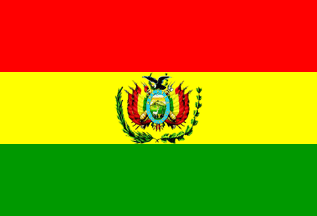Military of Bolivia
|
Military of Bolivia |
|
|---|---|
 |
|
| Founded | August 7, 1826 |
| Service branches | Army (Ejército Boliviano), Navy (Fuerza Naval Boliviana, Air Force (Fuerza Aérea Boliviana), National Police Force (Policía Nacional de Bolivia) |
| Leadership | |
| Commander-in-Chief | President Evo Morales (Captain General of the Armed Forces) |
| Manpower | |
| Military age | 18 |
| Available for military service |
1,949,267, age 15–49 (2000 est.) |
| Fit for military service |
1,269,228, age 15–49 (2000 est.) |
| Reaching military age annually |
86,863 (2000 est.) |
| Active personnel | 55,500 |
| Expenditures | |
| Budget | $147 million (2006) |
| Percent of GDP | 1.9% (2006) |
| Industry | |
| Foreign suppliers |
|
The Armed Forces of Bolivia (Spanish: Fuerzas Armadas de Bolivia) are official organizations responsible for the defence, both of external aggression and internal Bolivia. They also ensure security, stability, and protect the Bolivian Constitution.
The armed forces are constituted by:
In addition, there are units formed by Bolivian Pre-militars (Premilitares), reserve corps, units serving mandatory, and the SAR-FAB of emergency and rescue unit.
The current command corresponds to the Admiral Armando Pacheco Gutierrez.
The Bolivian Army (Ejército de Bolivia, EB) is the land branch of the armed forces of Bolivia. Together with the Bolivia army and air force Bolivia, is responsible for protecting Bolivia of internal, external threats and ensure the independence of this country. The Bolivian Army has around 55,500 men. There are six military regions (regiones militares—RMs) in the army. The Army is organized into ten divisions. The Army maintains a small fleet of utility aircraft, primarily to support headquarters.
The Special Forces command controls the following units:
Army aviation company 291 (La Paz), army aviation company 292 (Santa Cruz)
The Bolivian Army has six military regions (regiones militares—RMs) covering the various Departments of Bolivia:
The army is organized into ten territorial divisions plus a mechanized division, each of which, with the exception of Viacha, occupy a region generally corresponding to the administrative departments, with some overlapping. These and their respective divisional headquarters and constituent units are:
RI: infantry regiment RC: cavalry regiment RA: artillery regiment Bat.Ing.: battalion engineer
Army organized has ten divisions controlling the following units:
The Army maintains a small fleet of utility aircraft, primarily to support headquarters.
Army officers, NCOs, and enlisted personnel wear generally gray or, for tropical areas, gray-green service uniforms. Army fatigue uniforms were olive green, and combat uniforms were of US woodland pattern camouflage. The standard headgear for enlisted personnel is the beret bearing the national colors of red, yellow and green. Paratroops (paracaidistas) were distinguished by black berets, and Special Forces by green berets.
The Bolivian air force (Fuerza Aérea Boliviana, FAB) is the air branch of the armed forces of Bolivia. The Bolivian Air Force has nine air bases, located at La Paz, Cochabamba, Santa Cruz, Puerto Suárez, Tarija, Villamontes, Cobija, Riberalta, and Roboré.
...
Wikipedia
